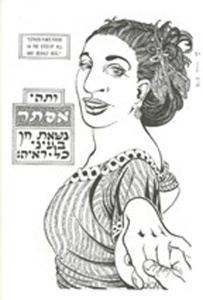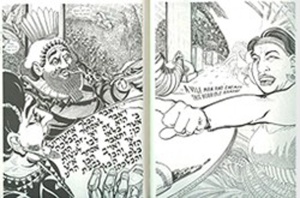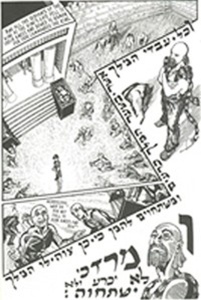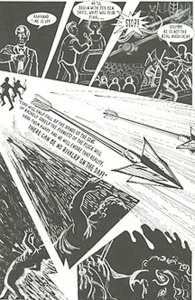The Graphic Novel by JT Waldman
JT Waldman’s Megillat Esther is brash, loud and groundbreaking. Created as a graphic novel it is the first time the megillah has been illustrated in this radical late 20th century art form. Nonetheless, the question remains; can a comic book express the complexity of the Book of Esther?

Megillas come in all shapes, sizes and kinds. There are cute little portable scrolls encased in finely wrought silver, large unadorned parchment scrolls piously unrolled to follow along on Purim eve, beautifully bound books with Hebrew and English text and commentaries, and cheap pamphlets handed out to the crowds who flock to shul once or twice a year. So too the illuminated megillah is seen in many different forms from purely decorative ornamental borders to finely entwined illustrations of the ancient tale, each character lovingly depicted; Esther is beautiful, Haman ugly and Ahashverous regal. There are a handful of illuminated megillas from the 18th century (Germany) and a growing number of contemporary examples, almost all depicting the events as occurring in their Persian historical context. Elaborate costumes abound and much of the pictorial motifs are couched in the ornate visual language of the Persian miniature, carefully surrounding blocks of sacred text.
Waldman’s megillah is radically different from all that came before. His visual model, the graphic novel, is uniquely capable of depicting multiple scenes that elapse through time on a single page, much like flipping though motion picture stills to give the appearance of real-life action. He utilizes this technique extensively even while occasionally interrupting the narrative with interludes several pages long that form a kind of counter commentary on the main story, asserting that the Book of Esther is but one part of “a greater saga” of the history of the Jewish people as found in the rest of Tanach.
These interludes (traditional and non-traditional commentaries) are mapped out in the frontispiece, a “Tree of Abraham,” that depicts the family tree of human life starting with Abraham as the trunk and finding Mashiach ben David and Mashiach ben Joseph along with Haman in the upper branches. Additionally it includes: Rachel, Leah; Judah and Joseph; Bezalel and Joshua; David and Saul; Esau, Eliphaz and Timna, all of whom appear somewhere in this megillah.

The story of Timna’s senseless rejection by the family of Abraham found in Sanhedrin 99b, her subsequent marriage to Esau’s son Eliphaz and giving birth to the vicious Amalek interrupts the megillah twice. It forms both a poignant prelude and achingly insightful interlude that probes the justification for Amalek’s (and hence Haman’s) genocidal hatred of the Jews. Waldman’s schema insists upon asking the intractable questions all of us try to avoid. Is the Jewish struggle for survival simply a matter of us verses them, or perhaps it is also a kind of internecine warfare?
Waldman worked four years on this megillah and produced a volume 172 pages long including extensive lists of rabbinic sources, bibliography and background on the various interludes. As his first illuminated Jewish text he felt that Megillah Esther was a perfect place to start because it is a uniquely Diaspora narrative immediately accessible to a modern-day Diaspora Jew. He created his megillah essentially from scratch, starting only with the Hebrew text, struggling to hammer out his own translation as he illustrated verse by verse. While he was learning in a progressive liberal yeshiva in Israel he simultaneously immersed himself in Talmudic commentaries and a vast spectrum of art sources ranging from the frescos at Dura Europus, Persian Court Painting to 20th century illustrations of Ephraim Moshe Lilien.
The process is painstaking, starting with a simple drawing of each individual scene, followed by the much longer process of inking the image and the calligraphy of the Hebrew text which Waldman also created. In this megillah the Hebrew never resides in well behaved little boxes. Rather the text takes on an especially dynamic presence, wrapping around scenes, shaping and providing emphasis to the images and operating as an integral part of the dramatic graphic design. After that the page is scanned and manipulated digitally, adding the English text, correcting minor flaws and adjusting contrast. The result is a breathtakingly complex, intense and at times, crowded set of images and text that leads us through the Megillah.

The artist was determined to explore what it means to be Jewish in a time when God is hidden. Megillat Esther provided that opportunity by Waldman’s emphasis that there be no pictorial distinction between Jew and non-Jew as is true in a pervasively assimilated society. As depicted where Mordechai refuses to bow to Haman he is seen with a shaved head and distinctly Persian styled beard. Throughout there is no sense of a Jewish people suffering in exile, rather all in the kingdom are equally oppressed and subject to the whims of the buffoonish king. Even the Hebrew, yehudi, is translated throughout as ‘Judean’, technically correct but totally distancing the reader from what was a watershed moment in Jewish history. Waldman explains that in today’s Diaspora, all Jews are Judeans, i.e. exiles from Judah and Jerusalem.
Based on the tone and format of super hero comics this graphic novel similarly treats the story of Esther in hyper-dramatic form. Vashti’s angry refusal to parade naked before the king is fleshed out with the queen stalking out of her bath shouting; “Tell him I have leprosy – or that I’ve grown a tail! I am not stable boy’s plaything!” This of course reflects the midrash even as the cartoonish reaction of the eunuchs in nail-biting terror provides a perfect prelude to the king’s burning rage. The artist plays every scene for all its dramatic potential even introducing Hegai, the king’s eunuch and keeper of women as a effete Persian/Indian character straight out of a 1940’s Hollywood stock production. All this leads to a somewhat camped up version of Esther, but considering our own wild costumes and outlandish traditions of the Purim spiel, not altogether inappropriate.
In what is the most dramatic moment of the book, the turning point in which the King’s sleepless night results in Mordechai’s triumph and Esther’s action to save her people, Waldman’s megillah literally is turned upside down on the page depicting the king’s nightmarish dreams. From here on the reader must read the captions from right to left and the turn the pages from left to right, exactly as one would a Hebrew book, thus fulfilling the dictum that on Purim everything is turned upside down.

In perhaps one of the most intriguing motifs running throughout the book, we are shown in an early interlude that “in a later Greek translation of the text, Mordechai has a dream, depicted here as a game show that determines who is the real Messiah,” a television face-off between Mashiach ben David and Mashiach ben Yosef. The show is interrupted by violence from the studio audience as they shout, “Esau will only fall by the hands of the sons of Rachel! Surely the youngest of the flock will drag them away! And we will ensure that reality. There can be no rivalry on the day!” As puzzling as this may initially be it starts to distill out in this formula; Haman is from Esau; Mordechai is from Benjamin son of Rachel as is Mashiach ben Yosef.
Waldman is convinced that underlying the megillah is the theme of sibling rivalry between all the descendants of Abraham. This is strikingly reflected in the very last interlude that we find placed in the tedious summation verses of Chapter 9. Suddenly a character appears shouting; “Stop!! The word has come to me!!” It is none other than Ezekiel proclaiming his vision in Chapter 37:15-23 of the two sticks incised with the name of Joseph on one and Judah on the other. They are placed together and become one, proclaiming “…and I will gather them on every side, and bring them into their own land. And I will make them one nation in the land of the mountains of Yisra’el. One king shall overlook them all. And they shall no more be two nations…”
The one thing that is certain is that the graphic novel, especially as seen here, is eerily suited to exploring a complex and multifaceted narrative. By means of intertwining normative text and midrashic material, a restless imagination and visual invention JT Waldman has created a megillah that opens up the possibilities of meaning and consequences in the Book of Esther. The struggle to remain vigilant and defeat our enemies emerges with a parallel demand for the urgent need to reconcile our Jewish rivalries and perhaps, just perhaps, understand that we must reconcile with our enemies as well because they just might be family too.
Megillat Esther by JT Waldman
The Jewish Publication Society, Philadelphia, Pa. (2005)
Megillat Esther: The Graphic Novel
Select Original Pages
The Bronfman Center Gallery
7 E 10th Street, New York, NY